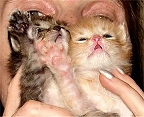Cats twitch the tips of their tails when hunting or angry, while larger twitching indicates displeasure. A tail held high is usually a sign of happiness. A half-raised shows less pleasure, and unhappiness is indicated with a tail held low. A scared or surprised cat may puff up its tail and the hair along its back and turn its body sideways to a threat in order to increase its apparent size. Cats with no tail, such as the Manx, who possess only a small stub of a tail move the stub around as though they possessed a full tail, though it is not nearly as communicative as that of a fully tailed cat. Touching noses is a friendly greeting for cats, while a lowered head is a sign of submission.
Happy cats are known to paw their owners, or that on which they sit, with a kneading motion. Cats often use this action alongside purring to show contentment and affection for their owners. It is instinctive to cats, and cats use it when they are young to stimulate the mother cat's nipple to release milk during nursing. As a result, cats that are hand-raised by humans may lack this reflex. Also, pawing is a way for cats to mark their territory. The scent glands on the underside of their paws release small amounts of scent onto the person or object being pawed, marking it as "theirs" in the same way they would urinate to mark their territory.

